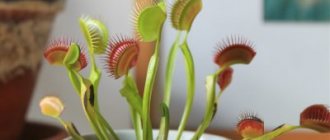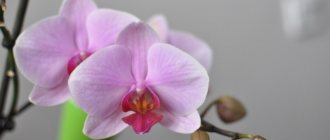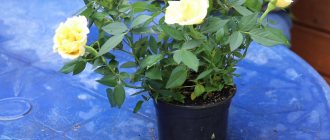However, for an indoor rose to take root, it will take a lot of effort. In the article we will talk about the basic rules for caring for indoor roses at home, the characteristics of the plant, the main varieties, methods of propagation and problems that can arise from improper maintenance.
Botanical description
Rose (Rosa) is a beautiful flowering shrub that belongs to the Rosaceae family. There are high (50-70 cm), low (10-30 cm) and medium (30-50 cm) shrubs .
Most varieties of indoor roses are heat-loving, but there are also varieties that are not picky about temperature conditions.
The shoots of the rose are straight or arched, covered with thorns. The leaves are compound, carved at the edges, imparipinnate. Flowers with a double perianth have a variety of sizes - from 1 to 16 cm in diameter. They can be either single or collected in inflorescences. Each flower contains many stamens and pistils.
The variety of colors is amazing. This plant has a huge number of shades: white, pink, yellow, purple, pink, scarlet, green. Roses are also famous for their pleasant aroma .
Indoor roses will delight you with their flowering if you provide them with good lighting, careful watering and timely pruning. Cut flowers can last in a vase for 5 to 10 days.
How to grow indoor rose?
It is easier to grow a decorative rose yourself from a cutting. You need to choose the summer months for this. The best time is June. Cuttings for planting must be freed from buds, leaving a couple of leaves and live buds.
Afterwards, the cuttings are placed for a day in a special solution to form roots. The rooting cut should be directly under the bud. There are different ways to root an indoor rose.
Varieties and photos
Below are photos, names and descriptions of indoor rose varieties suitable for propagation and care at home:
Baby Masquerade
This variety should be classified as a medium-sized shrub. Its height varies from 30-40 cm. It is noteworthy that Baby Masquerade has practically no thorns and powerful shoots of a dark green color.
The peculiarity of the variety is the ability of the flowers to change their color during flowering. Lemon buds change to pinkish, and at the end of flowering they become scarlet. Baby Masquerade smells pleasant and is resistant to fungal diseases, and therefore is a favorite among many other varieties. The photo below shows the Indoor Rose Baby Masquerade:
Angela Rippon
It belongs to a variety of miniature indoor plants, but despite this it is distinguished by a large number of fragrant flowers. Up to 5 buds are formed in one inflorescence. The maximum height of the bush is 40 cm. The variety is not demanding when it comes to pruning and is often susceptible to various diseases. You can see what the variety Indoor rose Angela Rippon looks like in the photo below:
This variety should be grown in small pots and fertilized frequently, including foliar feeding.
Fire Princess
The variety attracts the eye with its orange-red flowers framed by dark green foliage. The bushes are medium in size, the shoots are straight. Fire Princess is prone to fungal diseases and needs timely treatment with special preparations.
Hummingbird (Colibri)
The name of the variety is not accidental, because... has small bushes about 30 cm in height. However, its small size does not in any way affect its decorative effect. Hummingbird is famous for its rather large flowers - about 4-5 cm . with a pleasant aroma. The leaves are glossy and green very densely covering each stem. The flowers have an unusual color - from apricot to yellow.
Yellow Doll
This variety will not leave any gardener indifferent. The shrub is famous for its lush lemon-colored flowers. Each flower is crowned with a large number of petals - there are about 50 of them. Yellow Doll is very compact - only about 30 cm. In the photo below, the variety Indoor Rose Yellow Doll:
Green Ice
If you want to purchase a flowering rose variety, choose Green Ice. The shrub will not only delight you with its impressive size (about 60-65 cm), but also with year-round flowering. This variety is resistant to fungal diseases and does not require painstaking care. Despite the fact that Green Ice buds are pink, blooming roses become white with a greenish center. Each inflorescence produces from 2 to 5 flowers.
Care
House roses are quite demanding in terms of maintenance conditions. Many plants die immediately after being purchased and placed in a different microclimate. Therefore, we strongly recommend that you read the information regarding care.
How to care after purchase?
In the store, a rose usually looks beautiful and healthy, so when it comes home, the new owner thinks that no effort will be required from him to maintain the appearance of the flower. This opinion is wrong, because in the store the rose is fed with special additives , and if it gets into a different microclimate, the flower may die.
In most cases, yellowing of the foliage and blackening of the buds is observed, and then the death of the plant, even if the rose looked healthy and strong.
Any varieties of roses are intended for keeping in open ground. Some varieties have been “domesticated”, but growing indoors always poses considerable difficulties.
Immediately after purchasing a shrub, you should perform a number of actions:
- Remove the gift wrapping - it can interfere with proper air exchange and cause the development of dangerous fungus.
- Dry and blackened shoots, as well as limp leaves should be removed.
- Buds and flowers also need to be cut off, because... In most cases, their flowering is created artificially; the plant spends its energy on flowering, and then dies.
- Look how many bushes are in the pot, because... Often, to create the effect of a lush bush, several plants are planted in a pot at once, which interfere with each other. Therefore, if several shrubs are found, they should be planted in separate containers.
After transplantation, the shrubs will need treatment against fungal infections using Fitosporin, as well as prevention of pests with Fitoverm solution.
Lighting
It is better to place an indoor rose on a south window, because... the plant is demanding of light. Otherwise, the shrub will bloom poorly. At the same time, avoid direct sunlight and be sure to shade the window during the period of “active” sun.
In winter, in the absence of proper lighting, lighting with phyto lamps will be required.
Temperature
During the period of active growth, indoor roses will need at least 20-25 degrees of heat, but during the dormant period, 5-8 degrees will be enough. With the onset of spring, the temperature will need to be increased gradually.
Roses by nature love open ground, so in the summer, if possible, place the pot on the balcony or in the garden . Be sure to ventilate the room with the flower, avoiding drafts.
Humidity and watering
Watering must be adjusted from the very first days.
In summer it should be more abundant, in winter - a little less. Remember that the earthen ball should always remain slightly moist, otherwise the rose may shed its leaves. To avoid harming the plant, use settled water at room temperature, including for spraying.
Watering methods should be alternated , the first time watering the plant at the root, and the next watering in the pan. Excess water must be drained.
It is also necessary to maintain a high level of air humidity - at least 60-65%. Otherwise, the bush will be attacked by pests. In sunny weather, you should not spray the rose - this way you risk getting burns on the leaves. But in winter, the shrub needs to be moistened regularly or the pot should be placed on a tray with wet expanded clay.
Top dressing
Fertilizing an indoor rose should be carried out according to the following rules:
- in winter and during quarantine the flower is not fertilized;
- during flowering, frequent feeding will be needed - every 12-15 days;
- use both mineral and organic fertilizers, alternating them with each other.
Expert opinion
Vera Ivanovna Sh
Since childhood, I have been interested in growing indoor flowers, then I decided to devote my life to landscape design and gardening.
For mineral fertilizers, you will need special fertilizers purchased in the store. You can prepare organic fertilizers yourself using a solution of cow or bird droppings in a ratio of 1:10.
How to transplant?
We carry out the transplant as follows:
- Carefully remove the bush from the pot so as not to damage the roots.
- We place drainage consisting of pebbles or expanded clay in a pre-purchased container of larger diameter.
- We fill in the soil mixture and compact it well.
- We transplant the old plant into the middle of the container and, if necessary, add a little more soil.
- We water the rose generously, after which we treat it with Epin so that the plant can more easily adapt to the new environment.
- If the bush is small, cover it with polyethylene for speedy rooting.
We carry out subsequent care in the usual way.
Priming
The growth and health of indoor roses depends on the composition of the soil. You can purchase a ready-made substrate or make it yourself.
There are 2 options for preparing soil mixture , take the following components:
- 1 part of coniferous land;
- 1 part humus;
- 1 part sand;
- 1 part leaf soil;
- 3 parts of turf land.
Second option: 4 parts of turf soil and the same amount of humus, and then add 1 part of sand.
Pot
To grow a flower and actively grow, you will need a wide pot, because... in a small pot, the roots will not be able to develop normally and absorb nutrients from the soil.
Trimming
Timely, correct pruning helps to form a beautiful, healthy bush. The procedure is carried out during bud formation, as well as immediately after flowering. There are several pruning rules:
- branches growing inside the bush must be removed;
- weak and thin shoots also need to be pruned;
- faded flowers need to be cut off at the level of the first leaf - at the location of the bud;
- The branches need to be trimmed correctly, leaving 4-5 buds on them.
Growing at home
Landing
The first transplant is carried out two weeks after purchase. Choose a small pot, since in a wide and large container the soil begins to turn sour. The substrate is selected to be nutritious and loose. Buy a special one for roses or make it yourself. To do this, mix:
- garden soil;
- peat;
- sand;
- humus.
The procedure is carried out as follows:
- A drainage layer of expanded clay or river pebbles is poured onto the bottom of the pot.
- A little damp soil is poured on top.
- The plant is pulled out of the old flowerpot and, together with a lump of earth, placed in a new one.
- The remaining space is filled with substrate.
- Then the plant is watered and placed in a permanent place.
We invite you to watch a video on how to plant an indoor rose in a pot:
Conditions of detention
- Place. The plant develops best on southwestern and southeastern window sills. The room is regularly ventilated, since the rose needs fresh air, but drafts are not allowed. In the summer, it is taken out onto the balcony or terrace.
- Temperature. In spring and summer, the optimal temperature is 14–25 degrees. In winter, it should not exceed 5–8 degrees. Overheating negatively affects the flower.
- Humidity. The rose grows comfortably at an ambient air humidity of at least 50%. Therefore, on hot summer days it is sprayed daily. During dormancy, spraying is reduced to 2-3 times a week.
- Lighting. The plant loves bright, diffused light. At midday, the rose is shaded from direct rays of the sun, otherwise the leaves may get burned. In the winter season and when kept on northern windowsills, the pot is additionally illuminated with phytolamps.
- Watering. The rose needs regular watering. During the summer, daily. During dormancy, water moderately and less frequently, only to prevent the root system from drying out. Add water in small portions, since the plant is sensitive to excess moisture. After watering, the water is drained from the pan. Use warm, settled or filtered water.
- Feeding. From the spring-summer period, the plant is fed 2 times a month. In winter, once a month. Mineral mixtures for roses are used for fertilizer. The flower also responds well to organic fertilizers, for example, mullein in solution.
- Trimming. When preparing a rose for the dormant period, the procedure of pruning the plant is carried out. Remove all weak shoots and parts. The stems are shortened to 10 centimeters. Remove dried flowers and leaves regularly. The procedure is carried out with a sharp knife. If pruning is not carried out, the stems become very elongated and flowering becomes scarce.
- Transfer. The procedure is carried out after pruning and only when the old pot becomes small for the rose. The pot is selected 5–6 cm larger than the previous one. The plant is watered abundantly and carefully pulled out of the container. Together with the earthen lump, they are transferred to a new pot and soil is added. Place in the shade. The first feeding is carried out a month later.
- Prevention from pests and diseases. Most diseases of bush roses occur due to improper care. To prevent the appearance of pests and diseases, you need to take care of the living conditions and conduct regular inspection of the plant.
Reproduction
The rose is propagated by cuttings, which can take root in several ways. For planting , select lignified shoots up to 15 cm long . and separate them from the mother bush. Make sure that there are at least two buds on each cutting.
In water
For rooting in water, you will need annual shoots, which are prepared immediately after flowering. The procedure is as follows:
- Place the cuttings in a prepared container with water.
- Wait for the roots to form.
- Place the cuttings in pre-moistened potting soil and care for them as you would for adult plants.
In order for the cuttings to take root, it is necessary to provide them with a large amount of light, and periodically add water to the container.
In potatoes
To get a new plant, you will need 1 medium tuber. Make a hole in it and place the cutting there . The tuber itself should be planted in moistened sand, leaving the upper part on the surface. Cover the cutting with a plastic bottle or glass jar on top, water and ventilate the plant regularly.
In the substrate
To strengthen the cuttings in the soil and get new plants, you need to:
- Prepare a substrate from a mixture of humus and peat in equal proportions.
- Plant the cuttings, sprinkling them with sand on top.
- Cover the plants with a jar.
- As soon as the first leaves and roots appear, transplant into separate containers.
Preparing for transplant
For a new life of a bush rose, you need a pot larger than the previous one. The easiest way to buy soil is in the store. Also suitable for indoor roses is soil from under spruce trees with sand and peat. Such soil is disinfected with a hot solution of manganese in water.
Rotten roots, buds and flowers are removed. Before transplanting, you should treat the leaves with a soap solution. This prevents various flower diseases.
For three months of adaptation, the decorative rose must be sprayed with a growth stimulator at least once every two weeks.
Diseases and pests
Harmful insects often attack this beautiful and fragrant flower. In addition to pests, there is a danger of developing various diseases. Their presence is associated with improper conditions of detention. Therefore, every gardener should know what measures should be taken when certain signs appear.
Why do the leaves turn yellow?
Yellowing of the leaves of a rose indicates an excess of water in the pot. This can be either improper watering or stagnation of moisture in the roots of the plant. In this case, it is important to pay maximum attention to the flower: watering must be reduced and the rose must be allowed to adapt ; only the leaves can be moistened. If the soil is acidic, the bush must be transplanted into new soil.
To strengthen the immunity of yellowed shrubs, use complex fertilizers such as Greenward and Bona Forte.
Leaves are drying
Typically, the leaves of the plant dry out in winter, when the air in the apartment becomes too dry. In summer, during extreme heat, this behavior of the bush is also possible. In addition, the leaves of an indoor rose can dry out for a number of reasons:
- the root system is damaged;
- the soil does not receive enough moisture;
- the pot is located in close proximity to the radiator.
To restore the bush it is necessary to water it and also moisten it with a sprayer . If watering does not produce results, you need to check the roots for damage and, if necessary, separate the cuttings for seedlings.
The leaves are falling
Leaves may fall for several reasons:
- the plant was attacked by pests;
- an indoor rose sheds its leaves if it lacks warmth or there are drafts in the apartment;
- the bush is affected by a fungal or viral infection;
- Cold water was used for irrigation.
If you notice falling leaves on an indoor rose, you should take the following measures:
- damaged leaves are removed;
- inspect the surface of damaged leaves;
- when pests are detected, Fitoverm is used;
- in the presence of diseases (they can be identified by the characteristic mosaic on the leaves), special preparations are used, for example, “Fitosporin”.
White coating on leaves
This sign directly indicates the development of a fungal infection . In addition to plaque, plaques and growths may appear on the bush, and the leaves may become covered with small spots. To cure the plant, you will need to spray it with a solution of Fitosporin.
Why doesn't it bloom?
Sometimes it happens that the bush does not bloom. This is possible for a number of reasons:
- lack of proper fertilizing;
- insufficient lighting;
- the plant has not rested from the previous flowering;
- in case of untimely pruning.
Spider mite
This parasite appears when the air in the room is too dry.
Spider mites entangle the entire bush, sucking nutrients from it. The leaves of the plant turn yellow, wither, and then die. One of the measures to prevent ticks is a warm shower , which should be periodically given to indoor roses, after covering the soil with polyethylene. In difficult cases, this pest is destroyed with an insecticide solution.
As soon as you find a spider mite, the flower pot should be placed in “quarantine” - separately from other plants in the house. Don't forget to inspect the flowers adjacent to it.
Powdery mildew
White coating on the leaves and stems of indoor roses is direct evidence of the appearance of powdery mildew. This disease threatens with blackening of parts of the bush and subsequent death. If the plaque is small, spray the flower with a soda solution (2 teaspoons of soda per 1 liter of water). If the infestation is severe, fungicide treatment will be required.
Aphid
The appearance of aphids occurs when the plant’s immunity is weakened. reducing the high temperature in the room to normal and maintaining the necessary air humidity will come to the rescue
Expert opinion
Vera Ivanovna Sh
Since childhood, I have been interested in growing indoor flowers, then I decided to devote my life to landscape design and gardening.
Spraying the plant against pests with insecticides should be done outdoors in the shade. And only after a day can the pot be returned to its original place, otherwise you risk getting poisoned. Also remember to use gloves and an aspirator.
An indoor rose is perfect as a gift for any occasion. With proper care at home, an indoor rose will retain its attractive appearance, and after a while, new plants can be obtained from the bush. The main thing is not to neglect the rules of care presented in the article.











